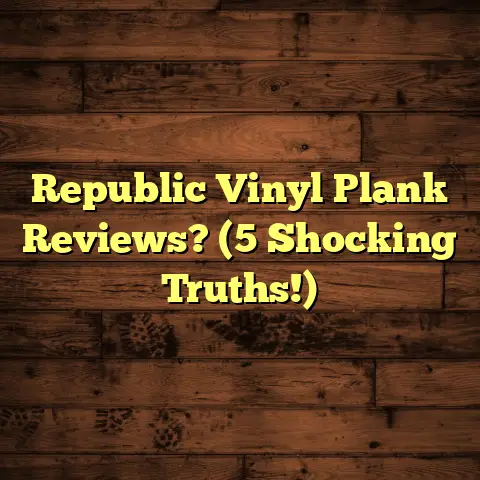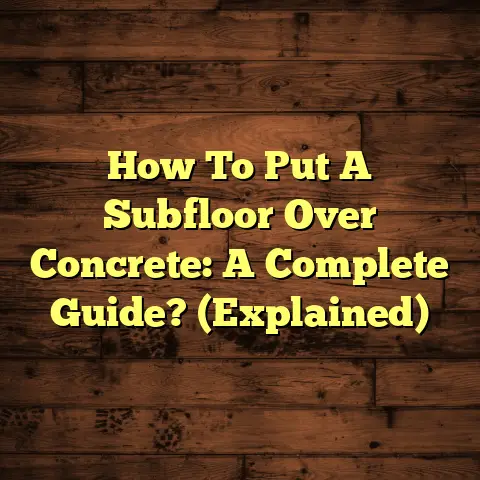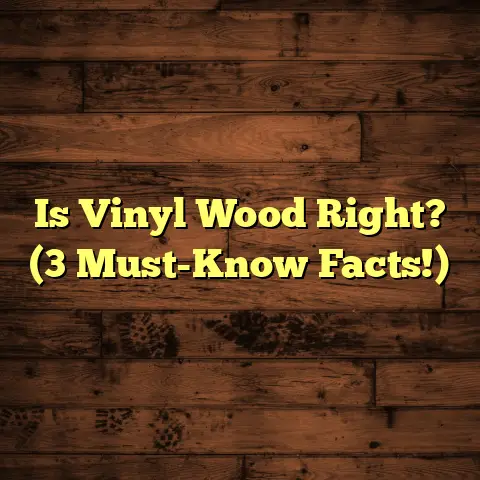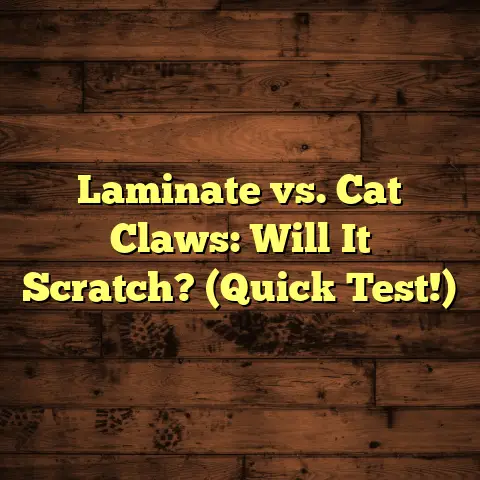Best Vinyl Plank Cleaner? (4 Leaving Dirty Residue!)
Vinyl plank flooring has become incredibly popular, and
for good reason.
It’s affordable, durable, and looks
amazing.
But here’s the thing: not all cleaners are created
equal, and using the wrong one can leave a nasty residue
that ruins the whole effect.
In this article, I’m going to spill the beans on the top 4
vinyl plank cleaners that are notorious for leaving behind
that dreaded dirty residue.
I’ll also give you some killer alternatives and share my
insider tips for keeping your vinyl floors looking pristine
for years to come.
Let’s dive in!
Section 1: Understanding Vinyl Plank Flooring
So, what exactly is vinyl plank flooring?
Well, it’s a multi-layered synthetic flooring product
designed to mimic the look of real wood or stone.
It’s typically composed of several layers, including a
wear layer (the top, protective layer), a printed design
layer, and a core layer for stability.
There are a few different types of vinyl plank flooring you might encounter:
- Luxury Vinyl Plank (LVP): This is the premium
option, known for its thicker wear layer, realistic
appearance, and enhanced durability.
It’s a fantastic choice for high-traffic areas and
homes with pets or kids. - Standard Vinyl Plank: A more budget-friendly option
that still offers good durability and water resistance.
It might not have the same level of realism as LVP, but
it’s still a great choice for many homes.
Now, why choose vinyl over, say, hardwood or tile? Here’s the lowdown:
- Water Resistance: Vinyl is virtually waterproof,
making it perfect for kitchens, bathrooms, and basements.
Hardwood, on the other hand, can warp and buckle when
exposed to moisture. - Ease of Installation: Vinyl plank flooring is
relatively easy to install, often using a click-lock
system.
You can even DIY it!
Tile installation, on the other hand, requires specialized
tools and skills. - Ease of Cleaning: This is where vinyl really shines.
It’s super easy to clean and maintain, as long as you
use the right products.
But here’s a common misconception: many people assume that
because vinyl is durable, you can use any old cleaner on it.
Wrong! Traditional cleaning methods and products,
especially those designed for hardwood or tile, can actually
damage the vinyl and leave behind a dull, sticky residue.
Why?
Because vinyl is a synthetic material with different
properties than natural materials like wood or stone.
The wrong cleaner can react with the vinyl, causing it to
break down or attract dirt.
Section 2: The Importance of Choosing the Right Cleaner
Alright, so you know that not all cleaners are created equal.
But why is it so important to use a cleaner specifically
designed for vinyl plank flooring?
Think of it this way: you wouldn’t use dish soap to wash
your car, right?
Each material requires a specific type of cleaner to
effectively remove dirt and grime without causing damage.
The same goes for vinyl plank flooring.
Using the wrong cleaner can lead to a whole host of problems,
including:
- Residue Buildup: This is the big one!
Many cleaners contain ingredients that don’t fully
dissolve or rinse away on vinyl.
Over time, this residue can build up, leaving your floors
looking dull, streaky, and just plain dirty. - Damage to the Wear Layer: Some harsh chemicals can
actually break down the protective wear layer of your
vinyl, making it more susceptible to scratches and stains. - Discoloration: Certain cleaners can cause the color
of your vinyl to fade or become discolored.
So, what’s the science behind this residue buildup?
Well, it often comes down to the pH level of the cleaner and
how it interacts with the vinyl.
Vinyl is generally resistant to acidic and alkaline
substances, but harsh chemicals can still cause problems.
For example, cleaners with a very high pH (alkaline) can
strip away the protective coating on the vinyl, while
cleaners with a very low pH (acidic) can etch the surface.
The ideal pH for a vinyl plank cleaner is generally neutral,
around 7.
You also want to look for cleaners that are specifically
formulated to be residue-free.
These cleaners contain ingredients that fully dissolve and
rinse away, leaving your floors clean and shiny.
Here are the key criteria I recommend considering when choosing a vinyl plank cleaner:
- pH Balance: Look for a cleaner with a neutral pH
(around 7). - Residue-Free Formula: Choose a cleaner that is
specifically designed to leave no residue behind. - Safety for Household Use: Make sure the cleaner is
non-toxic and safe for your family and pets. - Manufacturer Recommendations: Always check the
manufacturer’s recommendations for cleaning your specific
type of vinyl plank flooring.
Section 3: The Top 4 Vinyl Plank Cleaners That Leave Dirty Residue
Alright, let’s get down to the nitty-gritty.
Based on my experience and countless user reviews, here are
the top 4 vinyl plank cleaners that are notorious for
leaving behind that dreaded dirty residue:
1. Brand Name: Pine-Sol Multi-Surface Cleaner
- Product Overview: Pine-Sol is a well-known,
all-purpose cleaner that’s been around for ages.
It’s marketed as a powerful cleaner for a variety of
surfaces, including floors. - Ingredients: Key ingredients include pine oil,
surfactants, and solvents. - User Experiences: Many users have reported that
Pine-Sol leaves a sticky residue on vinyl plank floors,
especially after repeated use.
Some have also noted that it can dull the finish over time. - Why It Fails: The high concentration of pine oil in
Pine-Sol can be difficult to fully rinse away, leading to
residue buildup.
The surfactants and solvents can also strip away the
protective coating on the vinyl, making it more
susceptible to dirt and grime.
2. Brand Name: Mop & Glo Multi-Surface Floor Cleaner
- Product Overview: Mop & Glo is another popular
all-purpose floor cleaner that’s designed to leave a
shiny finish. - Ingredients: Key ingredients include acrylic polymers,
surfactants, and fragrance. - User Experiences: Users have frequently complained
that Mop & Glo leaves a waxy, sticky residue on vinyl
plank floors.
This residue can attract dirt and make the floors look
even dirtier over time. - Why It Fails: The acrylic polymers in Mop & Glo are
designed to create a shiny coating on the floor.
However, this coating can build up over time, creating a
sticky residue that’s difficult to remove.
3. Brand Name: Mr. Clean Multi-Surface Cleaner
- Product Overview: Mr. Clean is a household name when
it comes to cleaning.
Their multi-surface cleaner is marketed as a versatile
option for a variety of surfaces. - Ingredients: Key ingredients include surfactants,
solvents, and fragrance. - User Experiences: Some users have reported that Mr.
Clean leaves a hazy or streaky residue on vinyl plank
floors.
Others have noted that it can dull the finish over time. - Why It Fails: The surfactants and solvents in Mr.
Clean can be too harsh for vinyl plank flooring, stripping
away the protective coating and leaving behind a residue.
The fragrance can also contribute to residue buildup.
4. Brand Name: Murphy Oil Soap
- Product Overview: Murphy Oil Soap is a classic
cleaner that’s often used on wood floors.
It’s marketed as a gentle cleaner that won’t damage the
finish. - Ingredients: Key ingredient is refined vegetable oil.
- User Experiences: Despite being marketed as gentle,
many users have reported that Murphy Oil Soap leaves a
greasy residue on vinyl plank floors.
This residue can be difficult to remove and can attract
dirt. - Why It Fails: The oil-based formula of Murphy Oil
Soap is not suitable for vinyl plank flooring.
The oil can penetrate the vinyl and leave behind a greasy
residue that’s difficult to remove.
I know a lot of people swear by these cleaners, but trust
me, I’ve seen the damage they can do firsthand.
I’ve been called in to fix floors that have been ruined by
these products, and it’s not a pretty sight.
So, do yourself a favor and steer clear of these cleaners if
you want to keep your vinyl plank floors looking their best.
Section 4: How to Identify Residue on Vinyl Floors
Okay, so you’re wondering if you already have residue buildup
on your vinyl floors?
Here’s how to tell:
- Visual Indicators:
- Streaks: Look for streaks or lines on the floor,
especially after mopping. - Dullness: Notice if your floors look dull or
lackluster, even after cleaning. - Hazy Film: Check for a hazy or cloudy film on the
surface of the vinyl.
- Streaks: Look for streaks or lines on the floor,
- Tactile Signs:
- Sticky Feel: Run your hand over the floor.
Does it feel sticky or tacky? - Greasy Feel: Does the floor feel greasy or oily to
the touch?
- Sticky Feel: Run your hand over the floor.
- Impact of Environmental Factors:
- Humidity: High humidity can make residue buildup
more noticeable, as it can cause the residue to become
sticky and attract more dirt. - Temperature: High temperatures can also soften the
residue, making it more likely to attract dirt and
leave streaks.
- Humidity: High humidity can make residue buildup
Here are some tips on regular maintenance practices to minimize the appearance of residue:
- Sweep or Vacuum Regularly: This will remove loose
dirt and debris that can contribute to residue buildup.
I recommend doing this at least once a week, or more
often if you have pets or kids. - Use a Microfiber Mop: Microfiber mops are great at
picking up dirt and grime without leaving behind residue.
Make sure to use a clean mop head each time you clean. - Rinse Thoroughly: If you’re using a cleaner that
requires rinsing, make sure to rinse the floor thoroughly
with clean water.
This will help remove any remaining residue.
Section 5: Alternative Cleaners That Work
Alright, so we’ve covered the cleaners to avoid.
Now, let’s talk about the good stuff!
Here are some alternative vinyl plank cleaners that are
effective and residue-free:
- Bona Hard-Surface Floor Cleaner: This is one of my
go-to cleaners for vinyl plank flooring.
It’s specifically designed for hard-surface floors and
leaves no residue behind.
It’s also pH-neutral and safe for use around kids and pets. - Armstrong Flooring Once ‘n Done Floor Cleaner:
Armstrong is a trusted name in flooring, and their Once
‘n Done cleaner is a great choice for vinyl plank floors.
It’s a no-rinse formula that effectively removes dirt and
grime without leaving a residue. - Better Life Floor Cleaner: If you’re looking for an
eco-friendly option, Better Life Floor Cleaner is a great
choice.
It’s made with plant-derived ingredients and is free of
harsh chemicals.
It’s also effective at removing dirt and grime without
leaving a residue. - Puracy Multi-Surface Cleaner: This is another
eco-friendly option that’s safe for use on vinyl plank
floors.
It’s made with plant-based ingredients and is free of
harsh chemicals.
It’s also effective at removing dirt and grime without
leaving a residue.
These alternatives are all designed to maintain the integrity
of the vinyl while providing a thorough clean.
They’re pH-neutral, residue-free, and safe for use around
kids and pets.
Section 6: Tips for Maintaining Clean Vinyl Plank Flooring
Okay, so you’ve got the right cleaner.
Now, let’s talk about some practical tips for everyday
cleaning and maintenance to prevent buildup and extend the
life of your vinyl plank flooring:
- Routine Cleaning (Sweeping, Mopping):
- Frequency: Sweep or vacuum your floors at least
once a week to remove loose dirt and debris.
Mop your floors every 1-2 weeks, or more often if
needed. - Methods: Use a soft-bristled broom or a vacuum
with a hard-floor attachment to sweep your floors.
When mopping, use a microfiber mop and a pH-neutral,
residue-free cleaner.
- Frequency: Sweep or vacuum your floors at least
- Occasional Deep Cleaning:
- Frequency: Deep clean your floors every 2-3 months
to remove stubborn dirt and grime. - Methods: For deep cleaning, you can use a
slightly stronger cleaner, but make sure it’s still
pH-neutral and residue-free.
You can also use a steam mop to deep clean your floors,
but make sure to follow the manufacturer’s
instructions carefully.
- Frequency: Deep clean your floors every 2-3 months
- Using the Right Tools (Mops, Cloths):
- Mops: Use a microfiber mop for routine cleaning.
Microfiber mops are great at picking up dirt and grime
without leaving residue. - Cloths: Use soft, absorbent cloths for wiping up
spills.
Avoid using abrasive cloths or scrub brushes, as they
can scratch the surface of the vinyl.
- Mops: Use a microfiber mop for routine cleaning.
Here’s a little table to help you visualize a cleaning schedule:
Conclusion
So, there you have it!
We’ve covered a lot of ground in this article, from
understanding vinyl plank flooring to choosing the right
cleaner to maintaining your floors for years to come.
Remember, selecting the right vinyl plank cleaner is crucial
to avoid residue issues and keep your floors looking their
best.
Avoid the top 4 culprits I mentioned earlier, and instead,
opt for a pH-neutral, residue-free cleaner that’s
specifically designed for vinyl plank flooring.
Investing time and effort into proper cleaning and
maintenance practices is well worth it.
By following the tips I’ve shared in this article, you can
enjoy the beauty and longevity of your vinyl plank flooring
for years to come.
I hope this article has been helpful!
If you have any questions or comments, feel free to leave
them below.
And remember, a little bit of knowledge can go a long way
when it comes to keeping your floors looking pristine.
Happy cleaning!





